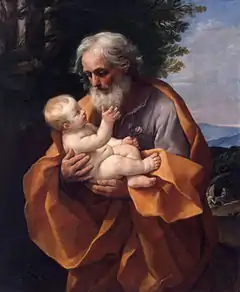Matthew 1:25
Matthew 1:25 is the twenty-fifth and last verse of the first chapter of the Gospel of Matthew in the New Testament. Joseph has awakened from a dream in which an angel gave him instructions about the birth of Jesus. He has taken Mary into his home, completing their marriage, and this verse explains what occurs once the couple is united.
| Matthew 1:25 | |
|---|---|
← 1:24 2:1 → | |
 Guido Reni's Joseph with the Infant Jesus | |
| Book | Gospel of Matthew |
| Christian Bible part | New Testament |
Content
The original Koine Greek, according to Westcott and Hort, reads:
- καὶ οὐκ ἐγίνωσκεν αὐτὴν ἕως οὗ ἔτεκεν
- υἱόν· καὶ ἐκάλεσεν τὸ ὄνομα αὐτοῦ Ἰησοῦν
In the King James Version of the Bible the text reads:
- And knew her not till she had brought forth her firstborn
- son and he called his name JESUS.
The World English Bible translates the passage as:
- and didn't know her sexually until she had brought forth her
- firstborn son. He named him Jesus.
For a collection of other versions see BibleHub Matthew 1:25.
Analysis
This verse suggests that Mary was a virgin at the time of Jesus' birth, and is cited as one of the scriptural evidences for the Virgin Birth. The word ἐγίνωσκεν literally translated "knew" refers often in the Bible to sexual relations. Eugene Boring says that in verses like this the author of the gospel seems to possess an extreme level of personal detail, while remarking that the command of the angel at Matthew 1:20 says nothing about avoiding sexual relations either before or after the birth of Jesus.[1]
This passage is the centre of controversy over the perpetual virginity of Mary. To many Protestants this verse is one of the central reasons for rejecting her perpetual virginity, seeing the author of Matthew, who states that sexual relations did not occur before the birth of Jesus, as implying that they occurred afterwards. Frederick Dale Bruner is one who interprets the word "until" as denoting that, after childbirth, "Joseph and Mary will live together completely as husband and wife."[2] Grant R. Osborne writes that "the imperfect tense denotes that Joseph at no time had sexual intercourse with his wife "until" after the birth of Jesus."[3] Presbyterian David Hill acknowledges that the wording does not absolutely deny Mary's perpetual virginity, but argues that if the idea of the perpetual virginity had been current at the time the gospel was written then the author of Matthew would have been more specific.[4] On the other hand, Martin Luther always believed in the virginity of Mary even after giving birth to Jesus.[5] Raymond E. Brown, a Roman Catholic, reports that K. Beyer states that in Greek and Semitic a negation until implies nothing about what happens afterwards; Brown himself says that Matthew is concerned only with stressing Mary's virginity at the time of giving birth to Jesus and not with what followed and he asks whether Matthew was in a position to know.[6]
As reported in Luke 2:21, the child was named eight days after his birth at the time of the circumcision. The phrase "he was called" in the original Greek (ἐκλήθη) is passive voice. However, in Matthew 1:21 Joseph is told he will do the naming. Robert H. Gundry believes that having Joseph name Jesus is a clear demonstration of Jesus' legal status as his son, and thus as an heir of King David, a continuation of the argument made by the genealogy.[7]
References
- Boring, Eugene "Gospel of Matthew." The New Interpreter's Bible, volume 8 Abingdon, 1995 pg. 135
- Frederick Dale Bruner (2004). Matthew a Commentary: The Christbook. Vol. 1, Matthew 1-12 (revised ed.). Wm. B. Eerdmans Publishing. ISBN 9780802811189.
- Grant R. Osborne (2010). Clinton E. Arnold (ed.). Matthew. Zondervan Exegetical Commentary on the New Testament. Zondervan Academic. ISBN 9780310323709.
- Hill, David. The Gospel of Matthew. Grand Rapids: Eerdmans, 1981
- Hartmann Grisar, Martin Luther, His Life and Work (Westminster, Maryland 1950), p. 210
- Brown, Raymond E. The Birth of the Messiah: A Commentary on the Infancy Narratives in Matthew and Luke. London: G. Chapman, 1977, p. 132.
- Gundry, Robert H. Matthew a Commentary on his Literary and Theological Art. Grand Rapids: William B. Eerdmans Publishing Company, 1982.
| Preceded by Matthew 1:24 |
Gospel of Matthew Chapter 1 |
Succeeded by Matthew 2:1 |
.jpg.webp)